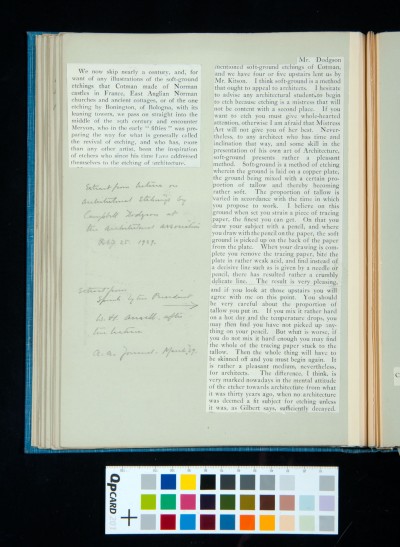Cotmania. Vol. III. 1928-9
Archive: SDK Sydney Decimus Kitson Archive
Reference Number: SDK/1/2/1/3
Page: 19 verso
-
Description
Extract from lecture on architectural etchings by Campbell Dodgson
Extract from speech by W. H. Ansell to Architectural AssociationExtract from lecture on architectural etchings by Campbell Dodgson
Extract from speech by W. H. Ansell to Architectural AssociationDate: 25 February 1929
-
Transcription
Extract from lecture on architectural etchings by Campbell Dodgson at the Architectural Association, Feb[ruar]y 25, 1929
We now skip nearly a century, and, for want of illustrations of the soft-ground etchings that Cotman made of Norman Castles in France, East Anglian Norman churches and ancient cottages, or of the one etching by Bonnington, of Bologna, with its leaning towers, we pass on straight into the middle of the 19th century and encounter Meryon, who in the early "Fifties" was preparing the way for what is generally called the revival of etching, and who has, more than any other artist, been the inspiration for etchers who since his time have addressed themselves to the etching of architecture.Extract from speech by the President W H Ansell, after the lecture, A. A. Journal March? 29.
Mr. Dodgson mentioned soft-ground etchings of Cotman, and we have four or five upstairs lent us by Mr Kitson. I think soft-ground is a method that ought to appeal to architects. I hesitate to advise any architectural studio to begin to etch because etching is a mistress that will not be content with second place. If you want to etch you must give whole-hearted attention, otherwise I am afraid that Mistress Art will not give you of her best. Nevertheless, to any architect who has time and inclination that way, and some skill in the presentation of his own art of Architecture, soft-ground presents rather a pleasant method. Soft-ground is a method of etching wherein the ground is laid on a copper plate, the ground being mixed with a certain proportion of tallow and thereby becoming rather soft. The proportion of tallow varied in accordance with the time in which you propose to work. I believe on this ground when set you strain a piece of tracing paper, the finest you can get. On that you draw your subject with a pencil, and where you draw with the pencil on the paper, the soft ground is picked up on the back of the paper from the plate. When your drawing is complete you remove the tracing paper, bute the plate in rather weak acid, and find instead of a decisive line, such as is given by a needle or a pencil, there has resulted rather a crumbly delicate line. The result is very pleasing, and if you look upstairs you will agree with me on this point. You should be very careful about the proportion of tallow you put in. If you mix it rather hard on a hot day and the temperature drops, you may then find you have not picked up anything on your pencil. But what is worse, if you do not mix it hard enough then you may find the whole of the tracing paper stuck to the tallow. Then the whole thing will have to be skinned off and you must begin again. It is rather a pleasant medium, nevertheless, for architects. The difference, I think, is very marked nowadays in the mental attitude of the etcher towards architecture from what it was thirty years ago, when no architecture was deemed a fit subject for etching unless it was, as Gilbert says, sufficiently decayed.
